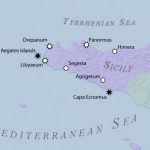The Phoenician colonization of the western Mediterranean, the controversial rivalry with the Greek settlers and the wealth of Phenicia are issues that are well known to people, even if only superficially interested in antiquity. But what was the process like? How has the community changed, creating new Semitic settlements on unknown lands?
Harbor – the most important element of a Punic city, right after the surrounding cultivated fields, which cannot be missed. The cities of civilization scattered over vast terrain had to be well connected with each other, which was possible only by sea. Cities were located according to certain fixed patterns: islands close to the mainland, surrounded by shallow waters (e.g. Motye), peninsulas protected on three sides by the sea depth (e.g. Carthage) or protected against winds and currents by bays (e.g. New Carthage) often chosen by Phoenicians.
The root of every Phoenician city was the temple (BT-bet?). The history of every city (HDST-hadast) from Morocco to Libya begins with the erection of its walls. During the first centuries of Phoenician expeditions into the unknown, none of the settlements exceeded the scheme of a temple surrounded by a small number of houses, an irregular square and a marina. They were shelters for traders and sailors, permanent points of trade, and not surrounded by walls, colossi like Carthage, Motye or Gadir from the 5th-2nd century BCE. At first, the colonies were sparse and scattered across the islands and the continent, and with time they became more numerous. During the heyday of Punic cities in the 3rd century BCE. reasonably placed coastal towns allowed for safe entry into port every night for any ship en route from Spain to Carthage.
With time, when the “shelters” grew richer thanks to trade and the number of their inhabitants grew, the settlements expanded. The houses were rebuilt depending on the available materials. Wooden buildings gave way to stone (e.g. stuccoed sandstone in northern Tunisia), more durable structures. In the villages, systems of cisterns, water pipes, gutters, cemeteries, temples and harbours were created. The developing cities did not resemble the clean, line-drawn Hellenic poleis. The dense tangle of narrow streets full of a rushing diverse crowd crowded houses and a distinctive, wider main thoroughfare leading from the port to the square – this is what Phoenician cities looked like in all corners of the Mediterranean. Nevertheless, in this disorder, we can distinguish the upper city, often surrounded by walls, occupied by temples, houses of wealthy residents, arsenals, gardens and the lower town full of poorer houses, cemeteries, leather stands Italians and traders.
Punic cities did not change until around the 4th century BCE. Conflicts with the Sicilian Greeks led to the introduction of new styles in art and the influx of skilled slaves, and the famous figure of Alexander of Macedon accelerated the process of Hellenization of the Mediterranean world. Classical Greek temples appeared in districts where a large proportion of the population was Greek. The settlements were fortified with massive walls of hewn stone joined with mortar, and the intersecting streets formed the perfect quadrangular “settlements” according to the plan of Hippodamos of Miletus. Not only buildings changed, but also people. Cults of foreign deities became popular, people dressed more and more in line with Greek fashions, and Punic art flourished, combining features of Egyptian, Syro-Palestinian and increasingly Greek.
Not every city survived the wars with Rome, some still function as small fishing settlements. However, it should be remembered that such centres as Cartagena, Tunis, Cadiz and Cagliari are metropolises that are part of the modern world thanks to mysterious, Semitic travellers and traders.







